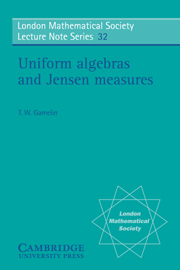Book contents
- Frontmatter
- Contents
- Preface
- 1 Choquet Theory
- 2 Classes of Representing Measures
- 3 The Algebra R(K)
- 4 The Corona Problem for Riemann Surfaces
- 5 Subharmonicity with Respect to a Uniform Algebra
- 6 Algebras of Analytic Functions
- 7 The Conjugation Opération for Representing Measures
- 8 The Conjugation Operation for Jensen Measures
- 9 Moduli of Functions in H2 (σ)
- List of Notation
- Index
5 - Subharmonicity with Respect to a Uniform Algebra
Published online by Cambridge University Press: 18 March 2010
- Frontmatter
- Contents
- Preface
- 1 Choquet Theory
- 2 Classes of Representing Measures
- 3 The Algebra R(K)
- 4 The Corona Problem for Riemann Surfaces
- 5 Subharmonicity with Respect to a Uniform Algebra
- 6 Algebras of Analytic Functions
- 7 The Conjugation Opération for Representing Measures
- 8 The Conjugation Operation for Jensen Measures
- 9 Moduli of Functions in H2 (σ)
- List of Notation
- Index
Summary
Let A be a uniform algebra on a compact space X, and let M denote the maximal ideal space of A. In this chapter, we continue the line of investigation begun in Chapters 1 and 2. We will introduce and treat various classes of “quasi-subharmonic” functions. The lower semi-continuous, quasi-subharmonic functions will be the log-envelope functions introduced in Chapter 2. The upper semi-continuous, quasi-subharmonic functions will be called simply “subharmonic”. The subharmonic functions in this context correspond to the subharmonic functions on an open subset of ¢, or to the plurisubharmonic functions on an open subset of ¢n.
The main theorems of this chapter are Theorems 5.9 and 5.10, asserting that a locally subharmonic function is subharmonic, while a bounded, locally log-envelope function is a log-envelope function. Our exposition will be based on work of the author and N.Sibony[3,4].
Quasi-subharmonic Functions
Let u be a Borel function from a subset S of MA to [-∞, +∞]. We say that u is quasi-subharmonic on S if u(φ) ≤ ∫udσ for all φ ∈ S and all Jensen measures σ for φ supported on a compact subset of S It is understood implicitly that the negative part of u min(u,0), is integrable with respect to the Jensen measures σ for those φ ∈ S satisfying u(φ) > -∞.
Evidently u is quasi-subharmonic on S if and only if u is quasi-subharmonic on each compact subset of S
A function u from S to [-∞, +∞) is subharmonic if u is upper semi-continuous and quasi-subharmonic.
- Type
- Chapter
- Information
- Uniform Algebras and Jensen Measures , pp. 54 - 82Publisher: Cambridge University PressPrint publication year: 1979



